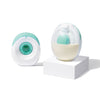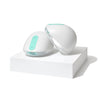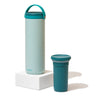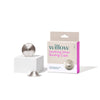This article was written in partnership with our International Board Certified Lactation Consultant, Wendy Wright, who loves working side by side with moms and babies to find that secret sauce! She’s also a mother of two and the Mom Experience Lead at Willow Pump.
Hey mama, did you know that 6% of moms in the US exclusively breast pump? That’s a lot of moms when you sit and think about it. Something that wasn’t even considered a generation ago is now completely available to anyone who chooses to use it. And that’s where we want to pause for a moment—this is your choice! How you decide to feed your baby is entirely up to you— we’re here to support you along the way.
Here's a quick guide on pumping times and sessions for children:
|
|
Newborn |
4-6 months |
6+ months |
|
Sessions/day |
8-12 |
5-6 |
3-4 |
|
Time/Session |
15 |
15-20 |
20 |
So, you’ve decided to be an Exclusively Pumping (EP) mom! One of the first things we hear is that setting up (or even thinking about) a schedule is overwhelming. Afterall, you’ve already got a lot going on! Wondering how to start? Keep reading for our LC’s best tips and tricks and what you need to know before starting your own.
Table of Contents
- How to Decide if Exclusive Pumping is Right for You
- How to Start Exclusively Pumping
- What Type of Pumping Schedule Should You Have?
- Sample Pumping Schedules
- How Often Should You Pump?
- How Long Should You Pump?
- How Long Should You Break Between Pumping Sessions?
- How Important is it to Stick to a Pumping Schedule?
7 Reasons You Might Decide Exclusive Pumping is Right For You
Breastfeeding simply isn’t for everyone, but there are options for you, mama. Exclusive pumping is one of many ways parents might feed their baby, and there are a million reasons why they choose this path.
-
Your baby is preterm, low-birthweight, or hospitalized, and pumping is the best way to get them breast milk immediately.
-
You and baby are having issues with the latch (this is so common!)
-
You had twins or multiples!
-
You’ve had previous breastfeeding challenges.
-
You have a career that requires being away from your baby for extended periods of time during the day.
-
You find breastfeeding painful, stressful, or difficult
-
You want to include your partner more regularly.
You’ve Decided to Exclusively Pump—Now What?
The most common thing we hear from our EP moms is that it’s just so damn demanding, it’s non-stop, and you’re constantly feeding or pumping. Setting up a well-structured, exclusive pumping schedule will not only help you feel organized from day one, but it will also eliminate some of the decision fatigue you’re already facing as a new mom.
What Type of Pumping Schedule Should You Have?
The type of pumping schedule you choose depends on your personal let-down periods, the amount of milk you store in advance, your daily schedule, and the amount of milk you can pump at each session. Not every woman pumps the same amount of milk per pumping session, so it’s important to get to know your own patterns when it comes to producing milk. Because of this, pumping in ounce measurements while keeping an eye on the time (15-20 minutes max!) will ensure you get the most out of the session.
Sample Pumping Schedules
Making an exclusive pumping schedule isn’t always easy when you are a busy mama! That’s why we took the time to create some great pumping schedule examples for you to work around. Remember that pumping schedules will differ depending on your baby's age, as their nutritional needs change over time.

What About Cluster Feeding?
Cluster feeding happens when your baby nurses frequently in a short period—often back-to-back for hours at a time. It can occur day or night and often leaves parents feeling exhausted and overwhelmed. While it may seem nonstop, cluster feeding is completely normal and usually tied to growth spurts. Babies often feed more during these phases to support their rapid development, especially at 2, 6, and 3 months of age. Every baby is different, but understanding this pattern can help make it a little easier to navigate.
Exclusive Pumping vs. Breastfeeding
Both breastfeeding and pumping come with unique benefits and challenges. Breastfeeding is cost-effective and offers valuable health benefits for both you and your baby, but it can be unpredictable and limit flexibility—especially when traveling or returning to work. Pumping, on the other hand, allows you to build and maintain milk supply, set more structured feeding times, and provide milk even when apart from your baby. However, it requires extra cleaning, maintenance, and investment in supplies.
LC Tip: If you choose to breastfeed exclusively, you can start implementing a feeding schedule once your baby reaches 2 months old. If you decide to exclusively pump, you should set a pumping schedule immediately. Typically, this means pumping every 2-3 hours for 15 to 30 minutes for newborns. As your baby gets older, you can decrease the number of pumping sessions you have in a day, depending on your milk supply.
FAQs
-
How often should you pump when exclusively pumping?
- In the first 1–6 weeks, aim to pump every 2–3 hours (about 8–10 times per day) to establish supply. As your baby grows, you can gradually reduce to 5–6 sessions by 3 months, 4–5 sessions around 6 months, and 1–2 by 12 months. Every baby and body is different, so adjust as needed.
-
How long should each pumping session last?
- Pump for about 15 minutes per side—or 20–30 minutes total with double pumping. Add an extra 5 minutes at the end to ensure your breasts are fully emptied, which supports future milk production. Avoid going much longer than 20 minutes per side, as shorter, consistent sessions are typically more effective.
-
How long should you exclusively pump?
- The American Academy of Pediatrics recommends exclusive breast milk feeding for the first 6 months. Many parents continue to pump beyond that while introducing solids, adjusting frequency as supply stabilizes. The first few months are the most intensive; over time, your sessions can become shorter and less frequent.
-
How long should you wait between pumping sessions?
- Avoid going longer than 5–6 hours between sessions early on to maintain supply. Working parents can aim to pump every 3–4 hours during an 8-hour workday. Staying consistent signals your body to keep producing milk on schedule.
-
When do babies typically cluster feed?
- Cluster feeding can happen anytime, day or night, but is most common during growth spurts or developmental leaps—often around 2 weeks, 6 weeks, and 3 months.
-
How can I prepare for cluster feeding?
- Keep a flexible feeding routine, stay hydrated, and have nourishing snacks nearby. Ask for support when possible—it can be emotionally draining. Protect your nipples with a soothing balm like Willow’s Mama Care Nipple Balm to reduce discomfort during frequent nursing sessions.
-
Can you start breastfeeding again after exclusively pumping for 6 months?
- Yes, it’s possible for many parents. Success often depends on why you began pumping. Work with a lactation consultant for guidance and take it slow. Even if your baby doesn’t fully latch, you’re still giving them all the benefits of breast milk.
-
How important is it to stick to a pumping schedule?
- Consistency is key. A regular pumping routine helps maintain your milk supply and signals your body when to produce milk. Irregular pumping can reduce supply and make sessions less effective.
No matter how you feed your baby, remember: you’re doing great. Willow is here to support every feeding journey.
Tags Used





